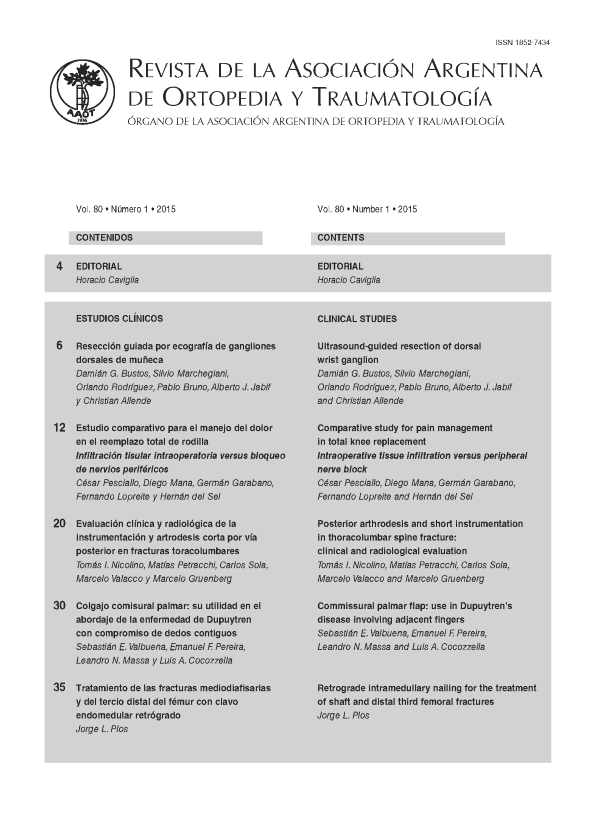Comparative study for pain management in total knee replacement: intraoperative tissue infiltration versus peripheral nerve block
Main Article Content
Abstract
Downloads
Metrics
Article Details

This work is licensed under a Creative Commons Attribution-NonCommercial-ShareAlike 4.0 International License.
Manuscript acceptance by the Journal implies the simultaneous non-submission to any other journal or publishing house. The RAAOT is under the Licencia Creative Commnos Atribución-NoComercial-Compartir Obras Derivadas Igual 4.0 Internacional (CC-BY-NC.SA 4.0) (http://creativecommons.org/licences/by-nc-sa/4.0/deed.es). Articles can be shared, copied, distributed, modified, altered, transformed into a derivative work, executed and publicly communicated, provided a) the authors and the original publication (Journal, Publisher and URL) are mentioned, b) they are not used for commercial purposes, c) the same terms of the license are maintained.
In the event that the manuscript is approved for its next publication, the authors retain the copyright and will assign to the journal the rights of publication, edition, reproduction, distribution, exhibition and communication at a national and international level in the different databases. data, repositories and portals.
It is hereby stated that the mentioned manuscript has not been published and that it is not being printed in any other national or foreign journal.
The authors hereby accept the necessary modifications, suggested by the reviewers, in order to adapt the manuscript to the style and publication rules of this Journal.
References
operations. Results of use for analgesia and preemptive blockade. J Bone Joint Surg Am 1996;78:734-8.
2. Barrington MJ, Olive D, Low K, Scott DA, Brittain J, Choong P. Continuous femoral nerve blockade or epidural analgesia
after TKR: a prospective randomized controlled trial. Anesth Analg 2005;101:1824-9.
3. Berry PH, Chapman CR, Covington EC, Dahl JL, Katz JA, Miaskowski C, McLean M (eds.). Pain: Current Understanding
of Assessment, Management and Treatments. Oakbrook Terrace, Illinois, Joint Commission on Accreditation of Healthcare
Organizations, 2001.
4. Berry PH, Dahl JL, Donovan MI, Fine PG, Miaskowski C, Stillman M, et al (eds.). Improving the Quality of Pain Management
through Measurement and Action. Oakbrook Terrace, Illinois, Joint Commission on Accreditation of Healthcare Organizations,
2003.
5. Bonica JJ. Evolution and current status of pain programs. J Pain Symptom Manage 1990;5:368-74.
6. Browne C, Copp S, Reden L, Pulido P, Colwell C Jr. Bupivacaine bolus injection versus placebo for pain management following
total knee arthroplasty. J Arthroplasty 2004;19(3):37.
7. Cook P, Stevens J, Gaudron C. Comparing the effects of femoral nerve block versus femoral and sciatic nerve block on pain
and opiate consumption after total knee arthroplasty. J Artrhoplasty 2003;18(5):583-6.
8. Clarke HD, Scott WN, Insall JN. Anatomía. En: Insall & Scott (eds.) Rodilla, Madrid: Marbán; 2004:13-76.
9. Dahl JB, Anker ME, Spansberg N, Schultz P, Christensen EF. Continuous lumbar plexus block alter arthroplasty. Anesthesia
1988;43(11):989-3.
10. Szczukowski MJ, Hines JA, Snell JA, Sisca TS. Femoral nerve block for total knee arthroplasty patients: a method to control
postoperative pain. J Artrhoplasty 2004;19(6):720-5.
11. Pesciallo C, Mana Pastrián D, Lopreite L, Astudillo F, del Sel Hernán. Infiltración intraoperatoria para el manejo del dolor en
la artroplastia total de rodilla. Rev Asoc Argent Ortop Traumatol 2009;74:55-62.
12. Weber A, Fourier R, Van Gessel E, Gamulin Z. Sciatic nerve block and the improvement of femoral nerve block analgesia after
total knee replacement. Eur J Anaesthesiol 2002;19:834-8.
13. Dorr LD, Chao L. The emotional state of the patient after total hip and knee arthroplasty. Clin Orthop Relat Res 2007;463:7-12.
14. Wang H, Boctor B, Verner J. The effect of single injection femoral nerve block on rehabilitation and length of hospital stay after
total knee replacement. Reg Anesth Pain Med 2002;27:139-43.
15. Mauerhan DR, Campbell M, Miller JS, Mokris JG, Gregory A, Kiebzak GM. Intraarticular morphine and or bupivacaine in
the management of pain after total knee arthroplasty. J Artrhoplasty 1997;12:547-52.
16. Ritter MA, Koehler M, Keating EM, Faris PM, Meding JB. Intraarticular morphine and or bupivacaine after total knee
replacement. J Bone Joint Surg Br 1999;81:301-3.
17. Lombardi AV, Berend KR, Mallory TH, Dodds KL, Adams JB. Soft tissue and intra-articular injection of bupivacaine,
epinephrine, and morphine has a beneficial effect after total knee arthroplasty. Clin Orthop Relat Res 2004;(428):125-30.
18. Vendittoli PA, Makinen P, Drolet P, Lavigne M, Fallaha M, Guertin MC, et al. A multimodal analgesia protocol for total
knee arthroplasty. A randomized, controlled study. J Bone Joint Surg Am 2006;88:282-9.
19. Cousins MJ. Pain: The past, present, and future of anaesthesiology. The E.A. Rovenstine Memorial Lecture. Anesthesiology
1999;91:538-51.
20. Curtiss CP. JCAHO: Meeting the standards for pain management. Orthop Nurs 2001;20:27-30.
21. Hirst GC, Lang SA, Dust WN. Femoral nerve block. Single injection versus continuous infusion for total knee arthroplasty.
Reg Anesth 1996;21:292-6.
22. Hunt K, Bourne MH, Mariani EM. Single-injection femoral and sciatic nerve blocks for pain control after total knee arthroplasty.
J Arthroplasty 2009;24(4):533-8.
23. Toftdahl K, Nikolajsen L, Haraldsted V, Madsen F, Tonnesen EK, Soballe K. Comparison of peri- and intraarticular analgesia
with femoral nerve block after total knee arthroplasty: a randomized clinical trial. Acta Orthop 2007;78(2):159-61.
24. Parker DA, Coolican MRJ, Mather LE, Graham DA, DeWall MJ. Safety of combined of local anesthethic infiltration and
reinfusion drains in total knee arthroplasty. J Arthroplasty 2009;24(6):918-24.

